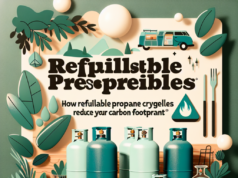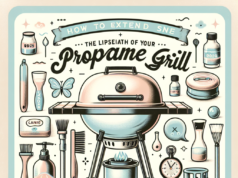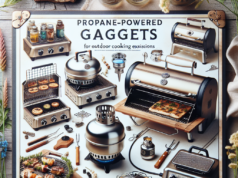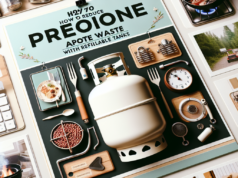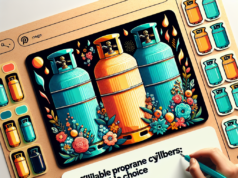High Intensity Propane Cooking Searing Torch in SALE
Contents
How to Safely Transport Propane Tanks for Camping
Propane tanks are a common source of fuel for camping stoves, heaters, and lanterns. However, transporting propane tanks can be dangerous if not done properly. Here are some tips to help you safely transport propane tanks for your camping trip:
- Make sure the propane tank is securely fastened in an upright position in your vehicle. Avoid laying it on its side or upside down, as this can cause leaks.
- Keep the propane tank in a well-ventilated area, as propane can be dangerous if it leaks and builds up in an enclosed space.
- Avoid storing the propane tank in direct sunlight or high temperatures, as this can cause the tank to overheat and potentially explode.
- Check the propane tank for any leaks or damage before transporting it. If you notice any signs of damage, such as dents or rust, do not use the tank and replace it with a new one.
- Always follow the manufacturer’s instructions for transporting propane tanks. This may include using a protective cover or securing the tank with a strap or bungee cord.
By following these tips, you can ensure a safe and enjoyable camping experience with your propane tanks.
Introduction
When going camping, propane tanks are essential for cooking, heating, and lighting. However, transporting propane tanks can be dangerous if not done properly. In this blog post, we will discuss how to safely transport propane tanks for camping.
1. Select the Right Tank
Before heading out on your camping trip, make sure to choose the right propane tank for your needs. There are different sizes available, so select one that is appropriate for the length of your trip and the amount of gas you will need.
2. Secure the Tank in Your Vehicle
Propane tanks should always be transported in an upright position. Use a sturdy and secure tank holder or cage to keep the tank from rolling or tipping over during transportation. Make sure the tank is also secured to prevent any movement while driving.
3. Ventilate Your Vehicle
Propane gas is heavier than air and can accumulate in enclosed spaces. To prevent any potential buildup of gas, make sure to keep your vehicle well ventilated during transportation. Crack a window open or use the vents in your vehicle to allow for proper airflow.
4. Avoid Direct Sunlight
Propane tanks should never be exposed to direct sunlight or high temperatures. Keep the tanks stored in a shaded area or covered with a tarp while in transit. Excessive heat can cause the pressure inside the tank to increase, leading to potential leaks or explosions.
5. Check for Leaks
Prior to transporting your propane tank, make sure to check for any leaks. Use a solution of soapy water to check for bubbles around the valve or connections. If you detect any leaks, do not transport the tank and seek professional assistance.
6. Store Safely Upon Arrival
Once you have reached your campsite, store the propane tanks in a safe and secure location. Keep them away from open flames, heat sources, or other flammable materials. Make sure the tanks are stored upright and in a well-ventilated area.
Conclusion
By following these safety tips, you can ensure that your propane tanks are transported safely for your camping trip. Remember to always handle propane tanks with care and caution to prevent any accidents or injuries.
Propane Tank Safety Tips for Campers
When it comes to camping, having a propane tank for cooking or heating can be essential. However, it’s important to transport and handle these tanks with care to ensure both your safety and the safety of those around you. Here are some tips for safely transporting propane tanks for camping:
1. Secure the Tank Properly
Make sure that the propane tank is securely fastened in an upright position in your vehicle. This will help prevent any potential leaks or accidents while you’re on the road.
2. Keep the Tank in a Well-Ventilated Area
Propane tanks should always be stored in a well-ventilated area to prevent the build-up of gas fumes. Avoid storing the tank in direct sunlight or near any heat sources.
3. Check for Leaks Before Use
Before connecting the propane tank to your camping stove or grill, make sure to check for any leaks. You can do this by applying a soapy water solution to the connection points and looking for any bubbles that form.
For more information on propane tank safety, you can visit this Wikipedia page.
High Intensity Propane Cooking Searing Torch in SALE
Frequently Asked Questions
How should I safely transport propane tanks for camping?
When transporting propane tanks for camping, it is important to follow these safety guidelines:
- Always make sure that the valve is tightly closed and the tank is in an upright position.
- Secure the tank in an upright position in a well-ventilated area of your vehicle, away from heat sources or flames.
- Never leave a propane tank in a hot vehicle or direct sunlight, as the pressure inside the tank can increase and cause a leak.
- Ensure that the tank is not damaged or leaking before transporting it.
Can I transport propane tanks in my trunk?
It is not recommended to transport propane tanks in your trunk. Propane tanks should always be transported in a well-ventilated area of your vehicle, such as the bed of a truck or the back of an SUV, to reduce the risk of a leak.
Are there any special precautions for transporting propane tanks on a camping trip?
When transporting propane tanks on a camping trip, it is important to store them upright and secure them properly to prevent them from rolling or tipping over. Additionally, keep the tanks away from open flames, heat sources, and direct sunlight to avoid pressure build-up and potential leaks.
Summary:
- Secure the Tanks: Make sure propane tanks are upright and secure in the vehicle to prevent tipping or rolling during transport.
- Keep Ventilated: Transport tanks in a well-ventilated area to prevent build-up of flammable gas.
- Check for Leaks: Before transporting, check tanks for leaks by using soapy water around connections.
- Don’t Store in Closed Spaces: Avoid storing propane tanks in closed spaces, such as the trunk of a car, as this can be dangerous.
- Follow Regulations: Be sure to follow any state or local regulations for transporting propane tanks.
High Intensity Propane Cooking Searing Torch in SALE
Video:
Category – Propane tank equipment































